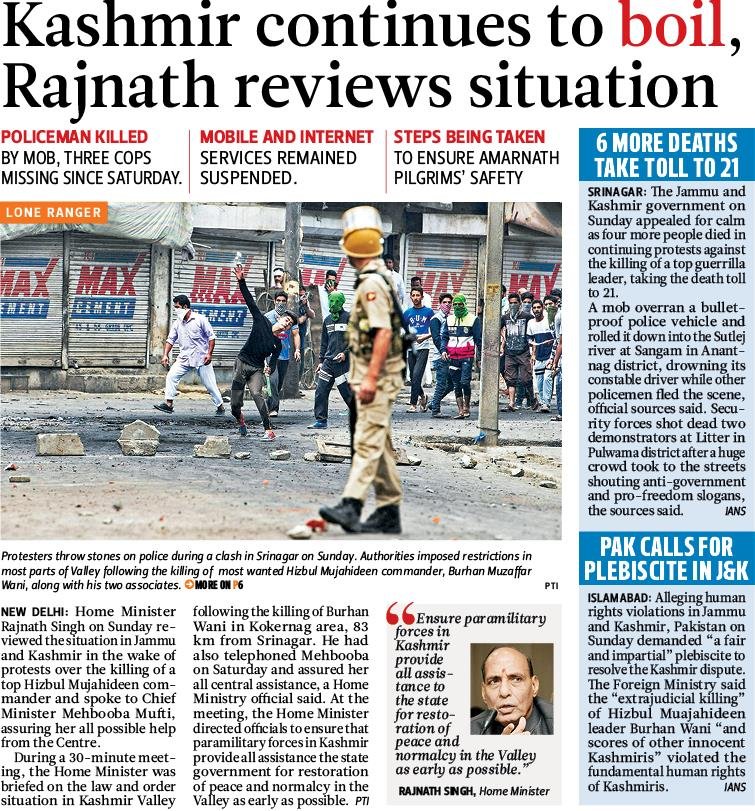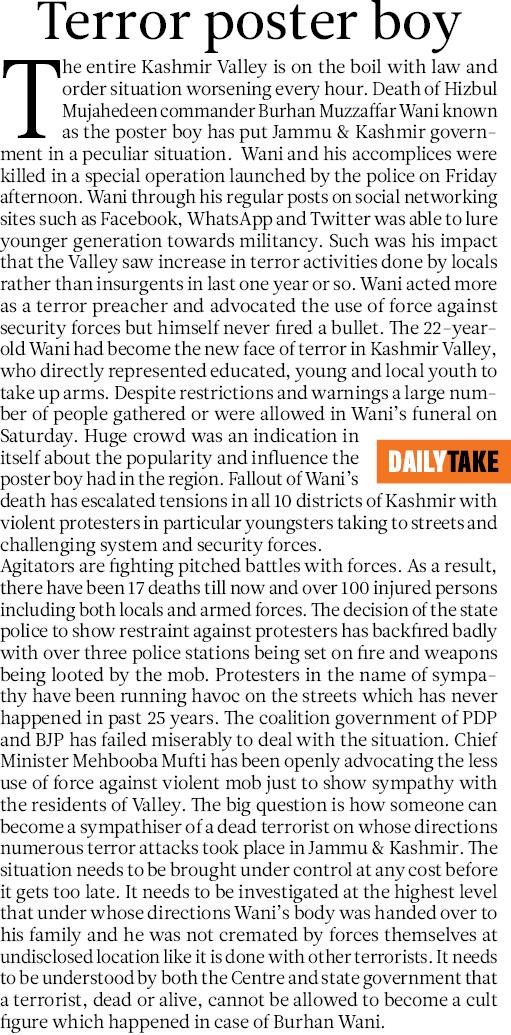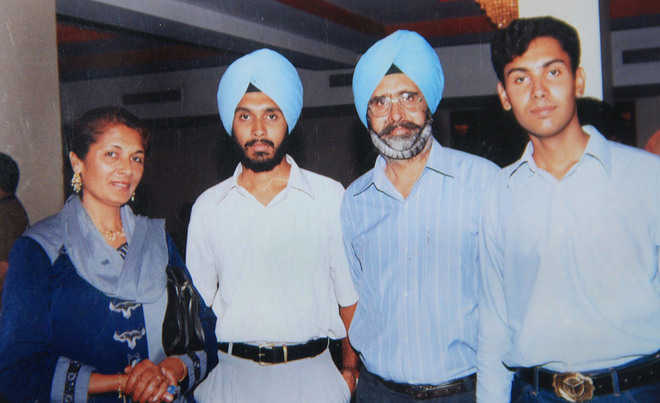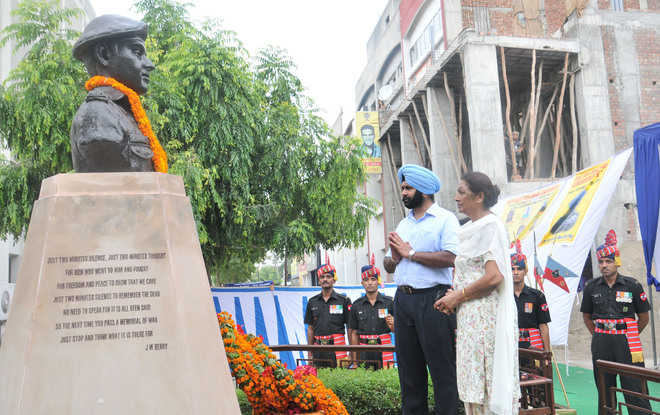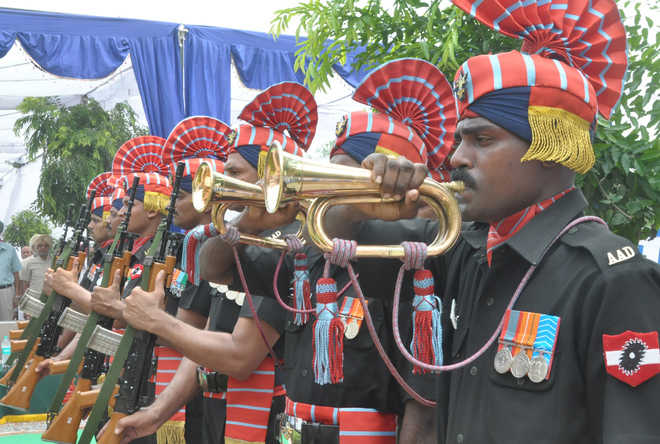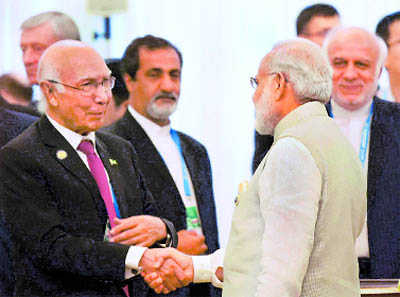 Protesters clash with the police in Srinagar on Sunday. Curfew continued to be in force in the old city areas and volatile Maisuama. PTI
Protesters clash with the police in Srinagar on Sunday. Curfew continued to be in force in the old city areas and volatile Maisuama. PTIMajid Jahangir
Tribune News Service
Srinagar, July 10
Kashmir continued to be on the boil on Sunday with the death toll in the violence that erupted following the killing of Hizbul Mujahideen commander Burhan Wani mounting to a staggering 21. Edit: Pen vs gun challengeOn an appeal by separatists, the Valley observed a complete shutdown today. A desperate Jammu and Kashmir Government, after a Cabinet meeting, appealed to various stakeholders, including separatists, to help restore normalcy. Mirwaiz Umar Farooq, though, was quick to reply, asking how they could appeal for peace when they were “caged and gagged”. (Follow The Tribune on Facebook; and Twitter @thetribunechd)In Anantnag district, angry protesters pushed a mobile police bunker into the Jhelum, killing a policeman, identified by the state police chief as Afroz Ahmad. The situation in Srinagar turned tense after a protester was killed in police firing while three civilians were killed in South Kashmir’s Pulwama district. Irfan Ahmed Malik was killed in Muran Pulwama. He was among a group of youths that came on to the streets, defying curfew restrictions. Gulzar Ahmed Pandit was killed in Lassipora after a police vehicle was torched. Fayaz Ahmed Waza died in Nilora during clashes with security personnel. Meanwhile, five youths wounded in the clashes on Saturday succumbed to their injuries today. They were identified as Haseeb Ganai of Batpora and Imtiyaz Mandoo of Nandpora in Anantnag district, Muzzaffar Ahmed of Keegam Shopian, Mashooq Ahmad of Qazigund in Kulgam district and Altaf Rather of Rajpora in Pulwama district. State police chief K Rajendra Kumar claimed the situation was under control and that “curfew has been imposed as a precautionary measure only in areas where there is tension”, despite reports of clashes having spread to Budgam, Kupwara, Ganderbal, Bandipore and Baramulla districts. In Kupwara, protesters set a building on fire. A GRP guard room, an RPF barrack at the Bijbehara Railway Station and a police post at Damhal Khushipora were set ablaze too. A building housing a police office at Soibugh Budgam was torched. Curfew was clamped in parts of Anantnag, Kulgam, Tral, Pampore and Awantipore, that saw violent clashes on Saturday. Meanwhile, there was still no word on the three policemen missing since Saturday.
We request all political forces, including the NC, Congress and CPM, and those as much concerned as we are, including leaders from the Hurriyat, to help restore peace. – Naeem Akhtar, Education MinisterWhat do they want us to do? They label us as a threat to peace and cage, confine and gag us. How can we be of help? – Mirwaiz Umar Farooq, Hurriyat leader
Kashmir burns in Wani’s wake
TOLL RISES TO 19 Mob kills cop by pushing vehicle into river; Pakistan says UN resolutions the answer
SRINAGAR: Kashmir Valley remained on the edge on Sunday with the death of 19 people in two days of public protests after security forces killed young Hizbul Mujahideen commander Burhan Wani, the troubled state’s latest poster boy of militancy.
 WASEEM ANDRABI/HTA protester throws stones at policemen in Srinagar on Sunday.
WASEEM ANDRABI/HTA protester throws stones at policemen in Srinagar on Sunday.
A youth was killed in the Tengpora area in Srinagar on Sunday, the first in the state’s summer capital. Unconfirmed reports put the death toll at 21 as violence spread to northern Kashmir as well.
The entire Valley remained shut with a string of police pickets and patrol trying to prevent stone-pelting protesters from marching on the streets. Mobile phone internet service has been blocked, while curfew was clamped across the Valley as clashes continued.
A policeman drowned after a mob in Anantnag pushed his vehicle into a gushing tributary of the Jhelum.
Groups of protesters clashed with security forces following news of Wani’s death on Friday evening. A dozen people died in the unrelenting violence on Saturday, while six more, including the policeman, were killed by mid-Sunday. The 22-year-old Wani, a popular social media-savvy militant, and two other militants were killed on Friday when security forces cornered them in the Kokernag area of Anantnag. A militant since 15, this schoolteacher’s son had apparently influenced scores of Kashmiri youth to join militancy in the past few years through slick social media posts and videos.
Pakistan, which has been accused of supporting separatism in Kashmir, called Wani’s death a condemnable case of extrajudicial killing. “Such acts are a violation of fundamental human rights of Kashmiris,” Islamabad said. It said the “Jammu and Kashmir dispute” could be resolved only “through a fair and impartial plebiscite” monitored by the UN.
The remarks came at a time the coalition government of the Peoples Democratic Party and BJP as well as hardline separatist leader Syed Ali Shah Geelani appealed for calm. Geelani asked the youth not to attack police stations but protest peacefully. Arsonists torched three police posts when thousands of people participated in Wani’s funeral in his hometown, Tral, onSaturday. Three civil administration offices, the house of an MLA from the ruling PDP, several vehicles and a BJP office were targeted too.
Protesters torched a police station in the Soibugh area of southern Kashmir on Sunday, while militants hurled three grenades on security forces, injuring three.
Additional director general of police SM Sahai said 14 youth died of bullet or pellet wounds, one drowned during a police chase, while another was killed when his car met with an accident during the violence. According to reports more than 200 people, including 100 security personnel, were wounded.
Of these, 70 were being treated for grave bullet or pellet wounds, sources said. The worst-hit southern districts of Pulwama, Anantnag and Kulgam have been rigged with a tight security ring.
Fresh clashes were reported from southern Kashmir and most parts of Srinagar. The fatalities are reported from mostly southern Kashmir’s Pulwama, Anantnag, Kulgam and Bijbehara areas.
Many were wounded when police fired in the air to quell protests. The Jammu and Kashmir government held a special cabinet meeting to review the situation on Sunday. The cabinet, according to government spokesman Nayeem Akhtar, raised serious concerns about the deaths over the past two days. “Forces should exercise maximum restraint to ensure no collateral losses occur,” Akhtar said.
The government sought cooperation from political parties as well as separatists to ensure peace.
Barring hospitals, the Valley recorded a complete lockdown with private offices, business establishments and petrol pumps remaining shut for the second day. Authorities asked security forces to treat identity cards of government employees as curfew passes so that essential services are not affected.
Separatists extended their strike till Monday. Separatist leaders Syed Ali Shah Geelani and Mirwaiz Umar Farooq remained under house arrest, while Yasin Malik was under preventive detention.
The annual Amarnath Yatra pilgrimage from Jammu was suspended, as did mobile internet and rail services. Reports indicate that 140 militants are active in the Valley. Intelligence reports say the majority of local recruits – around 60 – are from southern Kashmir.



